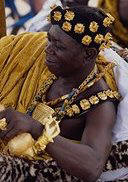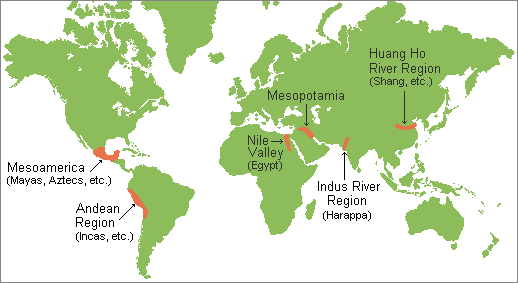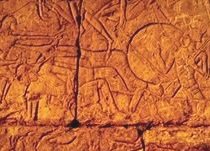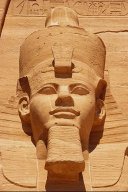Chiefdoms and States
Some horticultural societies of the past
developed more intensive agricultural subsistence patterns when their
populations grew into the thousands. As this interrelated economic and
populational transition
occurred, they were forced to create a new level of political integration
in order to maintain unity and order. This was the chiefdom and
ultimately the state. This marks the beginning of centralized, fulltime leadership and nonegalitarian
societies. Before examining the nature of chiefdoms and states, it is
important to keep in mind that the political systems in many societies do
not clearly fit either category completely. They are essentially in
transition from tribes to chiefdoms or from chiefdoms to states.
Chiefdoms
 |
|
| Fanti chief from Ghana in ceremonial regalia |
|
Chiefdoms are similar to
bands and
tribes in being mostly classless societies. However,
chiefdoms differ in having a more or less permanent, fulltime leader with real
authority to make major decisions for their societies. These
leaders are usually referred to by anthropologists as chiefs. Sometimes there is an advisory council as well, but
there is no bureaucracy of professional administrators. The
government is essentially just the chief. Some of the more advanced
chiefdoms in Africa are an exception in that they have a paramount chief
and lesser chiefs who perform administrative functions. The Baganda
![]() and Bunyoro
and Bunyoro
![]() of Uganda are examples
of this. The chiefdoms
of ancient Hawaii and elsewhere in
Polynesia were similar in having several levels of chiefs.
Chiefdoms also are known historically from Europe, Asia, the southeastern United States,
the Caribbean islands, Panama, Colombia, and the Amazon Basin of Brazil.
of Uganda are examples
of this. The chiefdoms
of ancient Hawaii and elsewhere in
Polynesia were similar in having several levels of chiefs.
Chiefdoms also are known historically from Europe, Asia, the southeastern United States,
the Caribbean islands, Panama, Colombia, and the Amazon Basin of Brazil.
Seniority in kin groups is usually the primary basis for individual status within chiefdoms. The chief is at the top of the kinship hierarchy. Other people are commonly ranked in terms of their genealogical distance from the chief. Subsequently, there is a keen interest in maintaining records of descent from important family ancestors.
Chiefs and their families generally have a higher standard of living than ordinary people. What makes this possible is that chiefs usually perform a society-wide economic redistribution function that, in some cases, is cloaked in the guise of ritual gift giving. This essentially siphons off surplus agricultural products from farmers and then redistributes them throughout the society. In the process, a small amount is held back in order to support the chief's more lavish lifestyle. The ritualized redistribution of surplus food and other commodities in chiefdoms is, in a sense, the rudimentary beginnings of a taxation system. It is probably tolerated by people because of the economic advantages that it can provide in addition to social stability. The larger territorial size of chiefdoms often encompasses diverse environmental zones with somewhat different products. The redistribution of surpluses can serve as a method of providing security in times of crop failures as well as greater food variety for the populace as a whole. For instance, a farmer may give up some of his crop but get different kinds of food in return along with enhanced status.
The larger populations of chiefdoms generally means that the people have less in common than do those in the smaller societies of bands and tribes. Disputes inevitably arise that cannot be settled by informal means based on kinship and friendship. A chief usually functions as an arbitrator and judge in these cases. In some of the kingdoms of West Africa, the paramount chiefs still today "license" official truth testers to deal with contradictory testimony in legal cases. They often use an ordeal to determine the truth. In the hot knife ordeal, only someone telling the truth is thought to not be burned when a red hot knife blade is stroked across his leg.
An important advantage that chiefdoms have over
band and tribal level societies when conflicts arise between them is that
chiefdoms are usually more effective in warfare. This is due to the
fact that chiefdoms have two important advantages. They have larger
populations so they can assemble larger military forces. In addition, the chief can provide centralized direction which
potentially allows more decisive action. Some chiefdoms in Western
South America had in excess of 100,000 people. The Chibcha
![]() of Colombia was one of them. They became a militarily powerful force in
the mountain regions that made up their homeland.
of Colombia was one of them. They became a militarily powerful force in
the mountain regions that made up their homeland.
Once functioning, the position of the chief usually becomes essential to the functioning of society. Chiefdoms cannot go back to a tribal level unless their population drops significantly.
States
State level political systems first appeared in societies with large-scale intensive agriculture. They began as chiefdoms and then evolved into more centralized, authoritarian kingdoms when their populations grew into tens of thousands of people. While chiefdoms are societies in which everyone is ranked relative to the chief, states are socially stratified into largely distinct classes in terms of wealth, power, and prestige.
Around 5,500 years ago, the early kingdoms of Ancient Egypt and Mesopotamia (now Iraq) developed such state levels of political integration. Shortly thereafter, states evolved in the Indian subcontinent and China. By 4,500 years ago, states were developing in Mesoamerica and the central Andean mountain region of western South America. The early states in these six regions became the well known ancient civilizations.
 |
|
Regions of ancient state political systems that evolved into complex civilizations |
While these six centers of early civilization had major cultural and historical differences, they created remarkably similar political solutions for dealing with the problems of feeding and controlling large complex societies. These new political systems had a pyramid of authority with a small hereditary elite class at the top headed by a king and royal family. At the bottom were the commoners who were the bulk of society. They were mostly the food producing farmers upon whom the entire society ultimately depended. In between was a small middle class consisting of two groups. First, there were professional craftsmen and traders who mainly produced or acquired luxury items for the elite. Second, there were professional bureaucrats who administered the state religion and government on a daily basis.
 |
|
Pyramid of power in ancient states |
As independent kingdoms within each of the geographic regions of the ancient civilization competed for land, water, and other important resources, warfare became more frequent and larger in scale. Professional armies were created along with more efficient weapons. In the Old World, these included horse drawn chariots, war ships, and metal swords, arrow, and spear tips. The consequence of these wars of conquest was powerful kingdoms destroying and annexing weaker ones. Eventually the victors ruled enormous multi-city, multi-cultural, and multi-language empires with millions of people living over vast areas. These super-states required even more centralization of authority and larger permanent armies.
| Professional armies have always been important tools of rule in ancient and modern states |
 |
 |
|||
| Ancient Egyptian army in battle | Modern national army |
All of the ancient civilizations were preindustrial agricultural societies with the majority of their populations living in hamlets and small villages. Most of these essentially rural societies only had one or a few small cities of about 5,000-50,000 people. These urban areas were primarily centers for the elite ruling class along with the state government bureaucracy and the majority of the fulltime craft specialists and traders who worked for them. In addition, cities were the locations of major temples of the state religions. At the top of the religious, political, and military hierarchies were key members of the ruling elite. There was not the separation of church and state that is characteristic of the U. S. and many other large nation states today. For instance, a prince could serve as an army general, a province governor, and a head priest at the same time. This was not viewed as a conflict of interest.
|
|
| Ancient Egyptians
believed their pharaohs were gods |
Ancient states were far from being egalitarian. There were a few rich, politically powerful people and many more comparatively poor commoners who had little political influence and almost no possibility of acquiring it. As single-city kingdoms became multi-city empires with vast territories, the political systems generally became more rigid. Not uncommonly, the ruler became a god-king with absolute authority. The Pharaohs of Egypt are a prime example of this. They were thought to be not just mortals but god-kings. As living gods, their authority was absolute.
Most ancient states had slavery. The conquest of competitor states usually provided most of them. Slaves were not always at the bottom of the pyramid of power in these societies. In Egypt and Mesopotamia, women slaves were often integrated into the households of wealthy, powerful men as servants and concubines. Slave children fathered by their owner sometimes acquired freedom and far higher status, wealth, and power than that of commoners.
NOTE: It is a common misconception that slavery no longer exists in the world today. Despite the fact that it is now illegal in all nations, the institution of slavery continues in the third world and even in modern industrialized nations in various forms. Millions of people are still being bought and sold, forced to work, physically constrained, and threatened with abuse if they don't comply with the wishes of their owners. At least 20 million people are "bond laborers" who must work long hours at unpleasant jobs for the person to whom they are financially indebted. In India and some other parts of South Asia, people often work their entire lives and fail to pay off their debt. It is passed on to the next generation. Their children continue as de facto slaves under this system without a realistic hope of escape. There is massive trafficking of Eastern European, African, and South Asian women and children who are tricked into emigrating "to better their lives" only to end up as unpaid servants or prostitutes. More traditional forms of slavery have also continued into the 21st century. In Sudan and some other parts of Africa, people are kidnapped from their homes to become life-long slaves, transported to other countries, bought, sold, inherited, and even given as gifts. Astonishingly, the price of these African slaves is now significantly cheaper than it was in the United States prior to the Civil War of the 1860's.
To learn more about slavery today, visit the following websites: 21st-Century Slaves, Anti-slavery International, and iAbolish. For a map showing the number of slaves coming into and going out of each country in the world see: "The Social Psychology of Modern Slavery" by Kevin Bales, Scientific American, April 2002.
Why Did We Give
Up Bands?
The transition from acephalous bands and tribes to chiefdoms and finally states mostly began after the end of the last ice age, 8,000-10,000 years ago. Archaeologists and historians have wondered why this occurred. After all, our ancestors had lived for hundreds of thousands of years as foragers. They most likely had band and tribal level societies over this vast amount of time. It would seem illogical to give up a successful egalitarian way of life for social, political, and economic inequality. A persuasive explanation is that this political and social transition was unavoidable given economic choices that were being made by our ancestors in response to major environmental changes and growing population pressure.
The dramatically altered climate at the end of the last ice age was largely responsible for the disappearance of many large mammal species that humans hunted at the time. In some regions, the animals became extinct and in others they were reduced in numbers to the point that they were no longer a dependable source of food. Human over-exploitation may have been a contributing factor as well. At the same time, vast lowland areas were being flooded by sea levels rising 300-400 feet as a consequence of massive continental glaciers melting. These changes did not occur over night. The climate had been warming for several thousand years. Unfortunately for our ancestors, all of these changes were occurring at the same time that the human population was growing.
Our ancestors were faced with a dilemma. Where could food be found to feed the ever larger number of mouths? In the arid river valleys that were to become the centers of the majority of ancient civilizations, this crisis was probably the most acute. The first response was to shift the focus of foraging to small game and wild plant foods, especially cereals. This was a stop-gap solution that allowed human populations to continue growing. Inevitably, plant and animal domestication were necessary to increase the food supply and make it more dependable. Horticulture and pastoralism were successful as long as the population density did not increase much. However, many of these societies continued to get bigger. Chiefdoms became a common solution to the problem of continued societal growth. The next evolutionary step was the development of intensive agriculture. This made the creation of the ancient states almost inevitable.
Why Did We
Develop States?
A number of theories have been suggested to explain why states appeared. Most of them are what have been called "prime mover" theories. That is, they assume that there is a single key factor responsible for state formation. The most well known ones are the voluntaristic theory , the hydraulic theory, and the coercive theory. All three attempt to summarize the primary forces that were responsible for state formation in most, if not all, of the early civilizations.
In 1936, the British archaeologist V. Gordon Childe first proposed the voluntaristic theory. This assumed that people made rational economic decisions that led them inevitably to develop the first states. Childe suggested that food surpluses created by early agriculture allowed some individuals to spend increasing time in developing more sophisticated weaving, pottery, and other manufactured products, while some others became full-time traders to distribute surplus food and luxury items. Markets appeared to facilitate trade and some individuals became wealthier than others. In order for this to happen the strong social pressure of the earlier egalitarian societies that forced people to share had to be replaced by the acceptance of individuals accumulating wealth. These changes created the need to develop new political solutions to the problem of mediating the differences between the various occupational and economic groups within society. A more centralized and less democratic political system was the outcome of this process in most cases. According to Childe, informed self-interest led people to accept the new political organization.
During the 1950's, the German historian Karl Wittfogel and the American archaeologist Julian Steward created an ecological explanation for state formation that has come to be known as the hydraulic theory. This proposed that state level political systems arose out of the need to construct and manage large-scale irrigation systems necessary for intensive agriculture within arid river valleys. Elaborate irrigation systems required leadership to organize the labor needed for this purpose. Wittfogel and Steward argued that once that leadership had come into existence, local control would increasingly pass to a permanent centralized ruling class. That elite class would be able to control farmers by denying water to those who resisted their authority.
In 1970, the American anthropologist Robert Carneiro developed the coercive theory of state formation. This proposed that states developed as a means of mobilizing armies to conquer competitive neighboring peoples. Carneiro suggested that increasing population pressure in early agricultural societies would have resulted in intensive competition with other societies for scarce resources such as land, water, salt, and wood. This would have triggered wars of conquest. Centralized state governments would have developed to mobilize and direct armies. According to Carneiro, those armies would continue to exist as tools for controlling conquered peoples, collecting tribute, and allocating resources.
All three of these prime mover theories of state formation have merit. Each one describes a piece of the puzzle. It is probably more realistic to think of the evolution of ancient states as having multiple causes that were intertwined with the unique set of environmental, social, and historical circumstances of each region. Just such a multi-cause explanation was proposed by the American archaeologist Robert Adams in the 1960's for the origin and evolution of early states in Mesopotamia. He observed that changes in a society, its culture, and the environment are always interrelated in complex ways like the organs of a human body. Different developments in evolving states would have triggered further developments which in turn would have affected the direction and rate of the initial developments. Eventually, some emerging states in Mesopotamia were more successful than others. Adams suggested that was usually because they had better resource bases and were able to control agricultural production over larger areas. This in turn gave them advantages in waging war. Once they began conquering their neighbors, they would have gotten tribute from the defeated states which would have reinforced the advantages of the successful conquerors. Adams suggested that all of these changes were inevitable due to the continued growth of the human populations.
Nation States
Today
Modern nation states ultimately replaced kingdoms and empires ruled by royal dynasties. However, there remain many crucial similarities. Nations today still are marked by social, political, and economic inequality. There is poverty for some while others are rich. Social mobility between classes is generally much easier now, but there remains a pyramid shaped distribution of economic and political power in all modern nations. Hereditary rulers have been almost entirely replaced by democratically elected leaders. However, those elected politicians still are at the top of the pyramid of power. One major difference between ancient and modern states is that the latter have far larger permanent bureaucracies. Their political power is centered in cities that dwarf most of those in the early states.
 |
 |
 |
||
|
Important seats of power in a modern nation state--buildings for
the head of state (ruler), legislature, and |
||||
The Future
While the ancient civilizations are long gone, the process that led our ancestors from small acephalous societies to chiefdoms and states did not stop. The world human population keeps on growing and most of our societies are becoming progressively more complex and interconnected globally. We constantly need to produce more food, fiber, and other materials in order to satisfy the growing demand generated by the additional people each year. Over the 21st century, much of the world very likely will face severe shortages, including those of food (especially protein rich meat), drinking water, arable land, and petroleum based fuels. We will be forced to be ever more creative in using them efficiently and to make hard decisions about their distribution in society. Those decisions probably will involve new political solutions in addition to technological ones.
This page was last updated on Monday, July 10, 2006.
Copyright © 2004-2006 by Dennis O'Neil. All rights reserved.
Illustration credits
